The San Francisco Bay Area energy system currently has 10,000 “control points,” according to Martin Keller, laboratory director at the Department of Energy’s National Renewable Energy Laboratory (NREL). But in the fast-approaching future of grid-interactive buildings — in which individual buildings will have multiple, programmable energy devices — that total could balloon to between 10 million and 20 million, Keller said during a session at the DOE’s Better Buildings, Better Plants Summit on Tuesday.
“The future of the grid will be so complex, and [there] will be so many controllable devices on our grid that the traditional way of controlling our grid will not work anymore. It will be autonomous,” he said. “It will be done by machine learning, by smart algorithms, and this is the challenge. How do we develop the algorithms to do all this, but also how do we keep it safe? How do we keep the bad actors away?”
Keller was one of three speakers at the session, which focused on the cutting-edge technology trends and advances coming out of NREL, the Pacific Northwest National Laboratory (PNNL) and the Oak Ridge National Laboratory. Cybersecurity emerged as a critical challenge for researchers at all three facilities.
“We’ve been working on developing methods for assessing cybersecurity in buildings and the systems in them,” said Angela Becker-Dippmann, director of energy and environment program development at PNNL. “We created a framework that provides a sort of heat map for a facility or installation that points toward the kind of cybersecurity considerations you might want to prioritize. From a federal perspective, it allows agencies to compare themselves to other agencies or compare buildings across their portfolio.”
But that technology is still in the “ground-truthing” stage, Becker-Dippmann said.
Thomas Kurfess, chief manufacturing officer at Oak Ridge, said that 35% of all cyberattacks in the U.S. target manufacturing facilities, primarily to steal intellectual property. “It’s not an issue of putting up a wall,” he said. “We’ve got to weave cybersecurity [into digital systems], and this will make sure that we can protect our proprietary information. You’ve got to be innovating faster than the competition.”
Keller also underlined the need to get the labs’ cutting-edge research to market faster. Noting that it took solar about 30 years to scale at competitive prices, he said; the timeframe for net-zero building technologies needs to be cut down to 10 years.
“The whole national lab system is complex,” Keller said. “How can we take the great ideas from universities, from other national laboratories and how can we scale [them] in a faster time frame, bring [them] to market faster?”
The key, he said, will be industrial collaboration — getting new technologies the labs develop to the companies that can scale and deploy them quickly.
‘Trickle-down’ Research
NREL’s answer to integrating millions of energy devices is Advanced Research on Integrated Energy Systems (ARIES), a computer platform that allows researchers to model energy systems using live data from different kinds of technologies and equipment, Keller said.
Using similar technology, the lab worked with Los Angeles to model whether and how the city could run on 100% renewable energy — it can — a project that Keller sees as a first step to providing community-level action plans that have a national impact.
But, he said, NREL and the national labs in general need to do a better job on working with low-income and disadvantaged communities. Traditional research models are “trickle-down,” Keller said.
“A lot of the time we’re focusing research on the first adopters of [new] technologies, but we also need to look into the historically marginalized communities and design research and experiments for these communities because it is different,” he said. “We really have to put much more focus on bringing everyone across this energy transition.”
Transactive Control
At the South Landing eco-district in Spokane, Wash., PNNL is demonstrating “new integrated and interoperable control approaches for the systems within the buildings, to coordinate the systems to respond to the needs of the local distribution system,” Becker-Dippmann said.
“We call this transactive control, which is a new approach we’ve developed on our own campus and in connection with other grid modernization projects in the past,” she said. “The idea here is to move from traditional demand response paradigms to autonomous demand management. Our ultimate goal is to design control approaches that are going to be turnkey solutions broadly available, as opposed to the custom jobs currently required for this sort of functionality.”
The eco-district now includes two commercial buildings, but Becker-Dippmann said the plan is to expand the system to provide benefits to two underserved communities. For another part of the project, the lab is working with state government “to examine rate and tariff structures and different use cases to explore potential services this shared energy model provides, and importantly, how best to properly and equitably value those services,” she said.
3D Printed Walls
One of the coolest things going on at Oak Ridge is Sky Big Area Additive Manufacturing (SkyBAAM), a new 3D printing technology that can print a concrete wall, Kurfess said.
“We have heating and cooling going through the wall. We have sensing in the wall so we can tell what’s going on with the temperature, and it’s very environmentally sound.”
He said workforce development will be essential for keeping the U.S. competitive in building and other advanced technologies.
Programs must focus not only on training the “next-generation workforce, but on making sure the current generation workforce fully utilizes these systems, making sure that we really match our workforce with our capabilities,” he said. “That’s going to keep us at the leading edge and keep us dominant in advanced manufacturing.”



